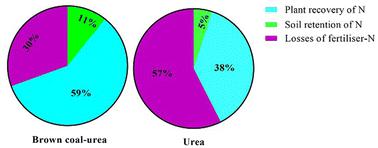当前位置:
X-MOL 学术
›
Environ. Sci.: Processes Impacts
›
论文详情
Our official English website, www.x-mol.net, welcomes your feedback! (Note: you will need to create a separate account there.)
Fate and recovery of nitrogen applied as slow release brown coal-urea in field microcosms: 15N tracer study
Environmental Science: Processes & Impacts ( IF 5.5 ) Pub Date : 2023-02-08 , DOI: 10.1039/d2em00482h Biplob K Saha 1 , Michael T Rose 2 , Lukas Van Zwieten 2 , Vanessa N L Wong 3 , Terry J Rose 4 , Antonio F Patti 1
Environmental Science: Processes & Impacts ( IF 5.5 ) Pub Date : 2023-02-08 , DOI: 10.1039/d2em00482h Biplob K Saha 1 , Michael T Rose 2 , Lukas Van Zwieten 2 , Vanessa N L Wong 3 , Terry J Rose 4 , Antonio F Patti 1
Affiliation

|
The over-use of synthetic nitrogen (N) fertilisers for crop production can cause environmental pollution through leaching and gaseous losses, resulting in low N use efficiency (NUE). Previous work has shown that brown coal (BC) combined with urea can slow down the fertiliser-N release to better synchronise soil N supply with crop N demand. The study aimed to evaluate the impact of granulated BC-urea (BCU) applied to sweet corn on NUE, fate and recovery of fertiliser-N using an 15N tracer technique. In this in-field microcosm study, 10 atom percent enriched 15N-labelled urea (46% N) and BCU (20% N) were applied as N fertilisers at rates of 90 or 180 kg N ha−1. On average, BCU fertiliser reduced the urea-derived 15N losses as nitrous oxide (N2O) by 64%, ammonia (NH3) by 73% and downward movement of total N by 59% compared to urea. Reduced losses of applied BCU fertiliser-15N were associated with significantly increased microbial immobilisation, soil retention and availability of fertiliser-15N to plants for longer periods of time, compared with urea. As a result, BCU enhanced cob yield by an average of 23%, 15N uptake by 21% and fertiliser NUE by 21% over urea. The plant recovery of fertiliser-15N was significantly higher from BCU (59%) than the recovery from urea (38%). Moreover, mining of native soil-N was lower when the N-fertiliser source was BCU cf. urea, suggesting that BCU could be used as a more N-efficient alternative to urea in cropping systems.
中文翻译:

在田间微观世界中用作缓释褐煤尿素的氮的归宿和回收:15N 示踪剂研究
在作物生产中过度使用合成氮 (N) 肥料会通过淋溶和气态损失造成环境污染,从而导致氮利用效率 (NUE) 低下。以前的工作表明,褐煤 (BC) 与尿素结合可以减缓肥料 N 的释放,从而更好地使土壤 N 供应与作物 N 需求同步。该研究旨在使用15 N 示踪技术评估施用于甜玉米的颗粒状 BC-尿素 (BCU) 对 NUE、归宿和肥料 N 回收率的影响。在此田间微观世界研究中,以 90 或 180 kg N ha -1的比率施用10 原子百分比富集的15 N 标记尿素 (46% N) 和 BCU (20% N) 作为氮肥。平均而言,BCU 肥料减少了尿素衍生的15与尿素相比,N 以一氧化二氮 (N 2 O) 的形式损失了 64%,氨 (NH 3 ) 损失了 73%,总 N 向下移动了 59%。与尿素相比,施用 BCU 肥料 - 15 N 的损失减少与显着增加的微生物固定化、土壤保持力和肥料 - 15 N 对植物的可利用性更长时间有关。结果,与尿素相比,BCU 将玉米芯产量平均提高了 23%,15 N 吸收量提高了 21%,肥料 NUE 提高了 21%。BCU 中15 N肥料的植物回收率(59%) 显着高于尿素 (38%) 的回收率。此外,当 N 肥料来源为 BCU 时,原生土壤 N 的开采量较低。尿素,这表明 BCU 可以在种植系统中用作尿素的氮高效替代品。
更新日期:2023-02-08
中文翻译:

在田间微观世界中用作缓释褐煤尿素的氮的归宿和回收:15N 示踪剂研究
在作物生产中过度使用合成氮 (N) 肥料会通过淋溶和气态损失造成环境污染,从而导致氮利用效率 (NUE) 低下。以前的工作表明,褐煤 (BC) 与尿素结合可以减缓肥料 N 的释放,从而更好地使土壤 N 供应与作物 N 需求同步。该研究旨在使用15 N 示踪技术评估施用于甜玉米的颗粒状 BC-尿素 (BCU) 对 NUE、归宿和肥料 N 回收率的影响。在此田间微观世界研究中,以 90 或 180 kg N ha -1的比率施用10 原子百分比富集的15 N 标记尿素 (46% N) 和 BCU (20% N) 作为氮肥。平均而言,BCU 肥料减少了尿素衍生的15与尿素相比,N 以一氧化二氮 (N 2 O) 的形式损失了 64%,氨 (NH 3 ) 损失了 73%,总 N 向下移动了 59%。与尿素相比,施用 BCU 肥料 - 15 N 的损失减少与显着增加的微生物固定化、土壤保持力和肥料 - 15 N 对植物的可利用性更长时间有关。结果,与尿素相比,BCU 将玉米芯产量平均提高了 23%,15 N 吸收量提高了 21%,肥料 NUE 提高了 21%。BCU 中15 N肥料的植物回收率(59%) 显着高于尿素 (38%) 的回收率。此外,当 N 肥料来源为 BCU 时,原生土壤 N 的开采量较低。尿素,这表明 BCU 可以在种植系统中用作尿素的氮高效替代品。


























 京公网安备 11010802027423号
京公网安备 11010802027423号